Are you a Quiet Speculation member?
If not, now is a perfect time to join up! Our powerful tools, breaking-news analysis, and exclusive Discord channel will make sure you stay up to date and ahead of the curve.
In terms of data, it seems Modern is at a crossroads. This is the problem I found myself with last week. Half the data said that Hogaak was a busted, dominate deck. The other said that it was successful, but only as a function of its popularity. The narrative coming out of last weekend is that Hogaak, Arisen Necropolis needs to be banned, which suggests the former interpretation is correct. However, there's data and experience supporting the opposite side.
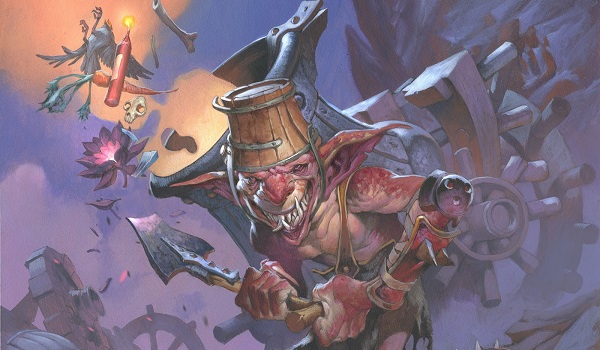
Sometimes this discrepancy is the result of differing perspectives. Once more data comes in or additional research is done, the source of error is found and corrected. For others, the contradiction was the real answer. I suspect this is the case with Hogaak. It is a very powerful deck, but not necessarily a good one.
No Eldrazi Winter
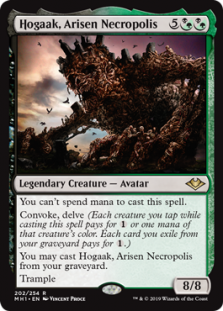 So what if Hogaak... is actually a bad deck? I realize that this flies in the face of a lot of testimony and evidence, but Hogaak simply doesn't seem on par with what we've come to understand as busted strategies. I've played Modern a long time, and Hogaak isn't in the same ballpark as Eye of Ugin Eldrazi. During Eldrazi Winter, that deck proved itself to be unbeatable for anything that wasn't Eldrazi. They weren't just the majority of the metagame; they also won almost everything. Hogaak didn't win a single event last week. Hyperbole aside, we've seen a lot worse.
So what if Hogaak... is actually a bad deck? I realize that this flies in the face of a lot of testimony and evidence, but Hogaak simply doesn't seem on par with what we've come to understand as busted strategies. I've played Modern a long time, and Hogaak isn't in the same ballpark as Eye of Ugin Eldrazi. During Eldrazi Winter, that deck proved itself to be unbeatable for anything that wasn't Eldrazi. They weren't just the majority of the metagame; they also won almost everything. Hogaak didn't win a single event last week. Hyperbole aside, we've seen a lot worse.
Hogaak's best starts are at best equivalent to Eldrazi's. Hogaak has some permutations to make 18+ power on turn 2 (if it hits well with Stitcher's Supplier), some of which will have 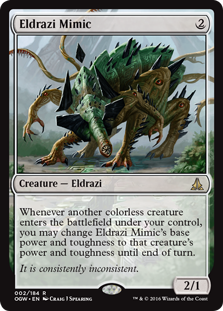 haste; probably, though not necessarily, enough to earn a concession. The most busted Eldrazi start called for Eye into four Eldrazi Mimics, then using Eldrazi Temple and Simian Spirit Guide to play Reality Smasher and actually win on turn 2. The problem for Hogaak is that it lacks the same consistency that Eldrazi had.
haste; probably, though not necessarily, enough to earn a concession. The most busted Eldrazi start called for Eye into four Eldrazi Mimics, then using Eldrazi Temple and Simian Spirit Guide to play Reality Smasher and actually win on turn 2. The problem for Hogaak is that it lacks the same consistency that Eldrazi had.
When that busted start didn't come together, Eldrazi was harder to disrupt than Hogaak. Graveyard hate coupled with removal cleans up non-lethal Hogaak boards. There was little hate that hurt Eldrazi effectively, especially when what answers existed would get stripped away by accelerated Thought-Knot Seers. Eldrazi was a pile of individual good threats where Hogaak has a couple key ones and a lot of chaff.
Empirical Data
My experience observing and playing against Hogaak has closely mirrored this video of Gabriel Nassif going 2-3 with the deck. He won a lot of blowouts and a couple squeakers, but more often he dug through most of his deck without accomplishing anything. Hogaak 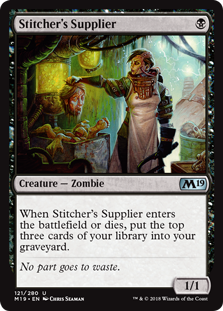 was incredibly powerful when everything came together, but when it didn't, the deck was anemic.
was incredibly powerful when everything came together, but when it didn't, the deck was anemic.
Over the past week, I haven't dropped a match in paper or online to Hogaak. It's not because I've successfully shut them out with normal hate cards, always hit Leyline of the Void, or found other answers. Instead, it's simply been Hogaak stumbling over itself. My game losses have all been utter blowouts on turn 2 or 3. However, I won the matches because that only happened in one game. In all the other games, Hogaak did a lot of stuff, but it didn't amount to much. One game my opponent had all the enablers and dug through 2/3's of their deck without finding Hogaak or Vengevine and lost when I Pathed his only real threat, Carrion Feeder. Hogaak doesn't inspire the same terror as Eldrazi.
Flawed Combo
The problem with Eldrazi was consistency and power. It did something too-good every game. Hogaak can do something utterly absurd some of the time, but other times it just flails around. Hogaak is a critical-piece and a critical-mass deck. It needs to have the right combination of enablers in hand and the right pieces in the top of its deck to flip into its graveyard to have those really busted starts. That's a lot of random chance at play.
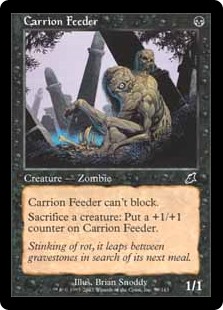 If Hogaak doesn't actually hit those busted starts, it can still play a decent secondary game as a medium Zombie aggro deck. Carrion Feeder gets quite big alongside Bloodghast and Gravecrawler, and even if it takes a long time to find Hogaak, an 8/8 with trample is a respectable threat. It's just not game-ending, unlike going infinite with Drowner of Hope and Eldrazi Displacer.
If Hogaak doesn't actually hit those busted starts, it can still play a decent secondary game as a medium Zombie aggro deck. Carrion Feeder gets quite big alongside Bloodghast and Gravecrawler, and even if it takes a long time to find Hogaak, an 8/8 with trample is a respectable threat. It's just not game-ending, unlike going infinite with Drowner of Hope and Eldrazi Displacer.
Hogaak is a deck with really busted starts, but struggles if instead it has average starts, and struggles to pull out longer games. It needs specific combinations of enablers and payoff cards. That sounds a lot like Legacy Belcher, but with a viable backup plan.
The Underrated Combo
So what if Legacy Belcher... is... not exactly a good deck, but better than its lack of metagame share or impact indicates. Belcher almost never sees serious Legacy play. This  is largely because the deck has a reputation for just losing to Force of Will, one of the most played cards in Legacy. However, that's not entirely accurate.
is largely because the deck has a reputation for just losing to Force of Will, one of the most played cards in Legacy. However, that's not entirely accurate.
Yes, failing to resolve a payoff card is generally lethal for Belcher. However, Belcher is also able to win turn one, either by actually comboing the opponent out or functionally kill with 14+ Goblin tokens. Given that the odds of having Force and the ability to cast it turn 1 are less than 40%, that's a huge plus in Belcher's favor. The reality is that Belcher has a higher likelihood of going-off turn 1-2 than just losing to Force.
The Catch
While a fear of Force is certainly a huge factor keeping out Belcher, the bigger problem is that Belcher is very high-variance. The deck needs to have a mana source to start comboing, but only plays one land. It 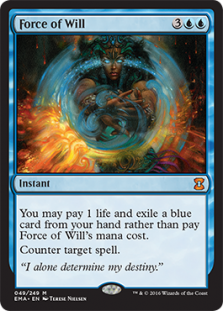 also needs a critical mass of mana to do anything. It also needs to hit Burning Wish, Empty the Warrens, or its namesake to win; that means it needs to draw one of eleven cards plus the right six mana sources to go off. If it opens the right hand, that's easy.
also needs a critical mass of mana to do anything. It also needs to hit Burning Wish, Empty the Warrens, or its namesake to win; that means it needs to draw one of eleven cards plus the right six mana sources to go off. If it opens the right hand, that's easy.
However, if any part of the chain is disrupted, Belcher may never have the resouces to go off again. And it has to go off, and the quicker the better. Belcher and similar decks are all-in on their fragile, resource intensive combos. If they fizzle or get disrupted, they're out so many resources that victory is improbable. At least Modern Storm can beat down with Goblin Electromancer. Thus, Belcher strategies is very high-risk and high-reward, and players aren't willing to gamble every round.
Comparative Metrics
Perhaps the reason that Hogaak's data is contradictory is that it is actually a good Belcher deck. It is high variance, high risk (vulnerability to graveyard hate), and high reward (fast kills), but it doesn't need to win fast. If the game goes on long enough, it can still win, even if the opponent has disrupted it a few times.
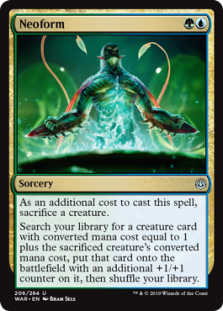 To evaluate this idea, I ran an experiment. I goldfished Hogaak against Belcher and Neoform (Modern's Belcher equivalent) to see how it stacked up. I played 30 games apiece, and each deck was given six turns to functionally or actually win the game. Functional wins are subjective, so I counted any board state that would make me concede if I didn't have an answer in hand. For example, few decks can beat 14 goblins turn 1, so that counts as a turn 1 win for Belcher.
To evaluate this idea, I ran an experiment. I goldfished Hogaak against Belcher and Neoform (Modern's Belcher equivalent) to see how it stacked up. I played 30 games apiece, and each deck was given six turns to functionally or actually win the game. Functional wins are subjective, so I counted any board state that would make me concede if I didn't have an answer in hand. For example, few decks can beat 14 goblins turn 1, so that counts as a turn 1 win for Belcher.
Also, for simplicity's sake, I only mulliganed truly unkeepable hands. Rather than going for the most busted hands, I went for acceptable ones.
| Win Turn | Belcher | Neoform | Hogaak |
|---|---|---|---|
| 1 | 3 | 2 | 0 |
| 2 | 10 | 6 | 7 |
| 3 | 6 | 5 | 10 |
| 4+ | 0 | 1 | 9 |
I'm told that Hogaak is able to win turn 1. That never happened for me, I've never seen it before, and I'm skeptical that it ever could in real conditions. However, despite being slower, Hogaak won a lot more than Neoform or Belcher. Hogaak only failed to win in the time frame four times compared to Belcher's 11 and Neoform's 16.
Hogaak's gameplay also felt very similar to the other decks, but better. There were a lot of feel-bad hands for the other decks that needed one piece, but couldn't find it, where Hogaak at least played some creatures each game even if it couldn't combo or fizzled.
A Follow-Up
Out of curiosity, I re-ran that experiment and mulliganed more aggressively, playing 10 games with each deck.
| Win Turn | Belcher | Neoform | Hogaak |
|---|---|---|---|
| 1 | 4 | 3 | 0 |
| 2 | 3 | 3 | 3 |
| 3 | 0 | 1 | 4 |
| 4 | 0 | 0 | 2 |
Hogaak mulliganed into oblivion and failed to kill once, while the other two failed three times.
Each deck improved its early game win percentage, with Belcher and Neoform getting more turn 1 wins in this sample than in the first one. Whether the overall win percentage would have been higher is impossible to say, but with early win percentages going up across the board, I argue that the factors impacting the true Belcher deck's early wins plays into Hogaak's too, which I argue makes Hogaak another form of Belcher deck.
Hogaak is Good Belcher
However, unlike its cousin decks, Hogaak doesn't need to Belch you out. It definitely wants to, and based on my experience doing so is Hogaak's best way to win. However, if that doesn't come together right away it's not the end of the world. It can just hard-cast threats.
 Belcher and Neoform cannot. If they don't win quickly, disruption will just kill them. As a result, they need to mulligan very aggressively, which often leads to losing to said mulligans. Since Hogaak doesn't need to be broken to win, it avoids this weakness. Thus, Hogaak may not be a good busted deck like Eldrazi was, but it is a better type of Belcher deck.
Belcher and Neoform cannot. If they don't win quickly, disruption will just kill them. As a result, they need to mulligan very aggressively, which often leads to losing to said mulligans. Since Hogaak doesn't need to be broken to win, it avoids this weakness. Thus, Hogaak may not be a good busted deck like Eldrazi was, but it is a better type of Belcher deck.
Therefore, the discrepancy in the data is the result of Hogaak's Belcher variance. As mentioned, Hogaak is a notoriously swingy deck. It's looking to do kill very quickly, but even with a nearly ideal opening hand it can't guarantee that it will come together. Unlike its cousin decks, this isn't a death sentence. It will just play the game out and hope things work out for the backup plan. Thus, I hypothesize that where a normal deck's variance graph would look like a sine wave, Hogaak's is more like sin(x³).
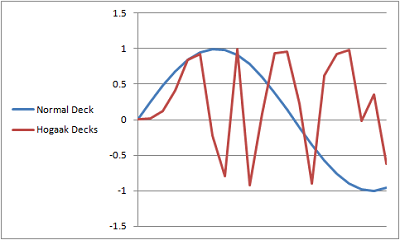
Thus, given a high starting population, it was certain that Hogaak would hit its best draws far more often that any other deck. That's just the law of large numbers in action. It also makes sense that it had high win percentage since at any given point it was more likely to have that high positive variance than the more normal deck.
As the field starts to dwindle, it becomes harder for the deck to avoid its bad draws and it begins to drop out. Therefore, under this theory, Hogaak dominated Day 2 standings but failed to turn that into Top 8 presence because you can't beat probability forever. Hogaak avoided the bad longer in the MC and Open, and so had a deck in the Top 8. It failed to do so in the GP and Classic, and so didn't appear.
Confounding Factors
The question that I can't really answer is: who's the big offender? I know that many 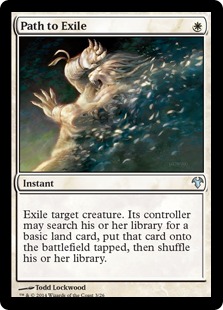 are calling for Hogaak itself to be banned (and Hogaak is A Very Stupid Card that Should Not Be), but I'm not certain that's the real problem with the deck. Hogaak decks aren't actually powerful because of the namesake. Hogaak is a big beater, notable only because it can be played on turn 2. The problem is that the deck is very good at getting Hogaak out alongside lots of other threats and ensuring they recur. Hogaak is a joke against Path to Exile, but Carrion Feeder makes Path a joke. A free 8/8 is powerful, but a swarm of free Vengevines is lethal. Hogaak is the face of the archetype, but I don't think it's the deck's lynchpin.
are calling for Hogaak itself to be banned (and Hogaak is A Very Stupid Card that Should Not Be), but I'm not certain that's the real problem with the deck. Hogaak decks aren't actually powerful because of the namesake. Hogaak is a big beater, notable only because it can be played on turn 2. The problem is that the deck is very good at getting Hogaak out alongside lots of other threats and ensuring they recur. Hogaak is a joke against Path to Exile, but Carrion Feeder makes Path a joke. A free 8/8 is powerful, but a swarm of free Vengevines is lethal. Hogaak is the face of the archetype, but I don't think it's the deck's lynchpin.
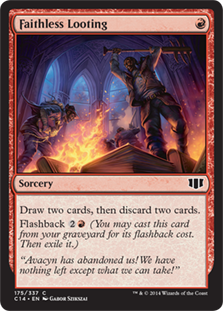 Hogaak and similar set-up-heavy cards sink or swim on the strength of their enablers. Faithless Looting is a fantastic card, but it's not the best enabler in Hogaak. That honor goes to Stitcher's Supplier and Carrion Feeder. The former represents 4-6 mana for Hogaak and finds the other payoff cards. The later protects everything from exile effects, digs with Supplier, and becomes an overwhelming threat as the game goes on. Wizards tends to ban enablers rather than payoffs, but there are so many enablers that I have to ask if they're willing to sacrifice multiple cards to save Hogaak.
Hogaak and similar set-up-heavy cards sink or swim on the strength of their enablers. Faithless Looting is a fantastic card, but it's not the best enabler in Hogaak. That honor goes to Stitcher's Supplier and Carrion Feeder. The former represents 4-6 mana for Hogaak and finds the other payoff cards. The later protects everything from exile effects, digs with Supplier, and becomes an overwhelming threat as the game goes on. Wizards tends to ban enablers rather than payoffs, but there are so many enablers that I have to ask if they're willing to sacrifice multiple cards to save Hogaak.
That Elephant Again
There's also a question of whether the problem is the deck or the London mulligan. As is well-established, decks like Hogaak benefit most from the rules change. Neoform wasn't viable without London, and neither was Bridgevine until Modern Horizons and the new mulligan. If Hogaak really is a combo deck, then reducing its consistency would functionally ban the deck. This suggests that the real problem is the London mulligan rule.
I don't know if this is true. My first test didn't allow for power-level mulligans, which London is apparently designed for, and Hogaak did pretty well. The second doesn't have enough data to draw conclusions other than as comparison between the three decks. I hypothesize that the mulligan is boosting Hogaak, but not as much as the deck's inherent swingy power. Actual testing is necessary.
What to Do
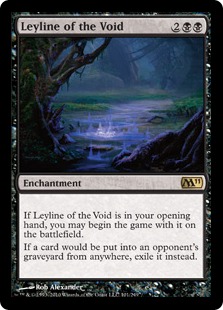 This begs the question of what's to be done about Hogaak. The data that I have right now is inconclusive, and I'm not willing to speculate on any potential bans. Belcher-style gameplay isn't fun or healthy for Magic, so I think Wizards will take action, but there's too much uncertainty for me to make predictions right now. There are a number of Modern events between now and August 26, including GP Las Vegas, and the data from there will ultimately determine Hogaak's fate.
This begs the question of what's to be done about Hogaak. The data that I have right now is inconclusive, and I'm not willing to speculate on any potential bans. Belcher-style gameplay isn't fun or healthy for Magic, so I think Wizards will take action, but there's too much uncertainty for me to make predictions right now. There are a number of Modern events between now and August 26, including GP Las Vegas, and the data from there will ultimately determine Hogaak's fate.
How players should prepare is a difficult question. The odds of seeing any 4-of in an opening hand is only ~40%, so trying to beat Hogaak with Leyline of the Void and/or Surgical Extraction is questionable. Hogaak is equally as likely to have an answer to hate as opponents are to actually have the hate, and the deck's alternate angles of attack further complicate hating it out.
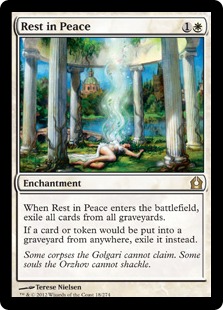 I'm beginning to think that players shouldn't necessarily bother to hate out Hogaak. Leyline is very powerful against Hogaak, but Legacy players don't specifically try to beat Belcher-style decks. They rely on generic answers and Belcher's inherent variance. Given that Hogaak is as likely to have an answer to Leyline as opponents are to having one, and are at least as likely to flame out as win turn two, is it even worth it to try beating Hogaak with hate? Should I care about the best starts or focus on beating the more average ones? A riddle for the ages.
I'm beginning to think that players shouldn't necessarily bother to hate out Hogaak. Leyline is very powerful against Hogaak, but Legacy players don't specifically try to beat Belcher-style decks. They rely on generic answers and Belcher's inherent variance. Given that Hogaak is as likely to have an answer to Leyline as opponents are to having one, and are at least as likely to flame out as win turn two, is it even worth it to try beating Hogaak with hate? Should I care about the best starts or focus on beating the more average ones? A riddle for the ages.
Data Incoming
August will be an interesting month. If I'm right about what Hogaak actually is, we should see it continue to put up enormous populations and win rates but fail to convert into Top 8 slots. You can't dodge the variance forever. If Hogaak is the huge threat that players claim, the data should prove it true. Now we wait.




I agree with most everything you’ve said here. A lot of your observations reflect the experiences I’ve had playing against the deck. I do think that a “good belcher” deck, as you called Hogaak, is fundamentally problematic. Just from people I’ve talked to, the problem seems to be the mental perception of the Hogaak deck as opposed to something like Grishoalbrand. Sometimes you get rolled 2-0 by Grishoalbrand on turn 2 both games, then the next time you have a turn 1 thoughtseize both games and the deck falls apart and you win 2-0 easily. Live by the free win, die by the free win, in a matter of speaking. Hogaak however, flips that script by winning a non-insignificant number of games when you do disrupt it, and thus feels much more broken, even though it may not ACTUALLY be that broken.